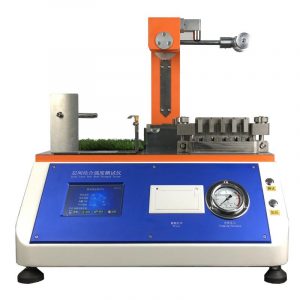Papier tube de fil pour l'application d'un mesureur de force de liaison intercouche
The interlayer bonding strength meter is also of great application value in the manufacture and use of yarn tube paper. Yarn-tube paper is a special paper product, which is mainly used in the processing and transportation of textiles in the textile industry. It has the advantages of light, soft and good moisture absorption. The internal bonding force tester can help manufacturers and users understand the internal bonding strength of yarns, thus improving the quality and reliability of yarns.

In the application of yarn paper, le testeur de force de liaison interne peut être utilisé pour tester la force de liaison entre différentes couches, as well as the overall bonding strength of the board. En testant la force de liaison interne de différents processus et matières premières, manufacturers can identify better production processes and raw materials to produce better yarn paper. En outre, the internal bonding force tester can also help manufacturers and users understand the internal bonding strength of yarn paper under different humidity and temperature conditions, thus determining its scope of application and service life.
Papier tube de fil pour l'application d'un mesureur de force de liaison intercouche
Dans le processus de test, similar to the test of electrical cardboard, electrical insulating cardboard and paper tube paper, it is necessary to prepare the test sample first, place it on the test bench, adjust the test parameters and start the test. Une fois le test terminé, the internal bond strength of the yarn paper can be evaluated according to the test results, afin d'améliorer la qualité et la fiabilité du produit.
Méthode de détection
The following are the specific test steps of the internal bonding force tester in the detection of yarn tube paper:
Préparer un échantillon de test: Cut a sample of a certain size from the yarn paper, généralement rectangulaire ou carré, la taille et la forme doivent répondre aux exigences du test.
Installer l'échantillon de test: Placer l'échantillon de test sur le banc d'essai du testeur de force de liaison interne, Alignez-le et serrez-le pour garantir que l'échantillon est fixé..
Ajuster les paramètres de test: selon les exigences du test, ajuster les paramètres de test du testeur de force de liaison interne, comme la vitesse de test, plage de pression, etc..
Commencer l'essai: démarrez le testeur de force de liaison interne et démarrez le test. Une fois testé, l'instrument appliquera une pression progressivement croissante jusqu'à ce que la séparation se produise entre les différentes couches. Pendant le test, la valeur de pression et la durée du test peuvent être enregistrées pour une analyse ultérieure.
Papier tube de fil pour l'application d'un mesureur de force de liaison intercouche
Analysis of test results: Une fois le test terminé, the internal bond strength of the yarn tube paper can be evaluated according to the test results. Si les résultats des tests répondent aux exigences, the internal bond strength of the yarn paper can be guaranteed, thus improving the quality and reliability of the product.
North and South Tide remind you: the yarn paper is usually soft and flexuous, so special attention should be paid to the clamping method of the sample and the stress distribution during the test. En outre, the yarn paper also has moisture absorption and expansion, temperature and humidity and other environmental conditions need to be controlled during the test to ensure the accuracy and reliability of the test results.
